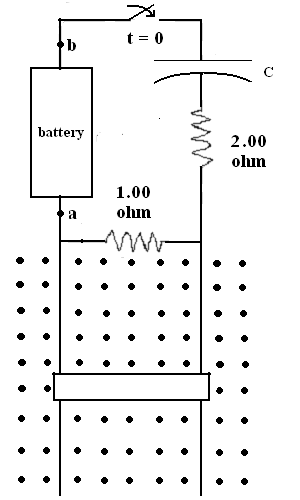|
REAL
TAKE HOME TEST 4 , 4B SP '12 |
|
1. (56
POINTS) CHAPTER 25 and 28 THEORY. Magnetic
field of a co-axial cable consisting of long wire surrounded by hollow tube. REFERENCES: The conducting material of both wire and tube has uniform resistivity ρ = 1.6800×10−8 Ω-m at 20 oC. GEOMETRY: L
= 1000.000 mm. Assume a = 2.000 mm, b = 4.000 mm and c =
6.000 mm and, as you see, L is MUCH, MUCH larger than either radii a, b or c. Applied between the ends of the coaxial cable is a
voltage difference V = 1.000x10 -3 ( V) = 1.000
mV a shown in fig. 2. It may be helpful to use supplied symbols ρ , V
, a,
b c or L or other
constants until the very last step when you plug in numbers to compute intermediate or final quantities. (a) (14 points) What is the magnitude B of the magnetic field inside
the wire a distance a/2 from the center?
using
B(2*pi*r) = uo*I(r2/a2), where = =4*pi*10 -7,
numerically. Set r = a/2. Note: I = 0.75 (A) from computation. using
B(2*pi*r) = uo*I, where = =4*pi*10 -7, numerically. Set
r = (a+ b)/2 = 3.000 mm. |
|
|
|
|
|
(a) (11 points) How long after the switch is closed will the voltage
across the capacitor reach a value of 35.00
(V)? (b) (33 points) What is the
value of the magnitude of the current
I at t = 5.00 x10 -3
seconds? (d) (5 points) What is the value of the magnitude Q of the charge on the capacitor’s positive plate at t = 5.00 x10 -3 seconds?
SOLUTIONS
OUTLINE: |
|
3. (55 points) CHAPTER 26 and 27 THEORY. The vertically
aligned RC
circuit shown is designed to exert an
upward magnetic force to accelerate objects upward
or downward in a gravitational field.
The mass to be accelerated is a horizontal
bar that slides on a frictionless,
vertical track made up of two
conducting wires connecting it to the circuit. In other words, the bar is constrained to
slide up or down the track under the influence of the gravitational and magnetic force only;
no friction. (a) (8 points) Given
that circuit
causes an upward magnetic force on the bar,
which point, a or b, should be the positive
terminal of the battery?
(e)
( 3 points) What essentially is the magnitude and direction of the bar's
acceleration at t = 2.500x10 -3 seconds (2.500 ms)?
(a)
From the right hand rule, the bar current must flow LEFT to exert an
upward magnetic force on bar; thus b is the higher voltage (positive)
terminal. |



